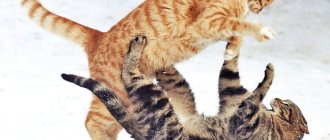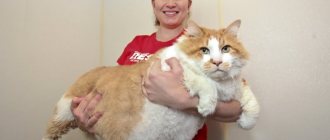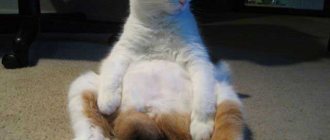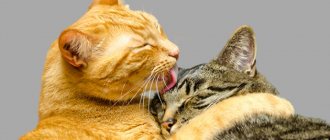Some questions, no matter how simple they may seem, are still unable to be answered by modern science. One of them is: why do cats and dogs fight with each other? It would hardly be a great exaggeration to say that the answer has interested people almost ever since both of these animals were domesticated. Their relationship, which has become a proverb and anecdote, is the subject of many fairy tales and legends in the folklore of different peoples of the world. The serious scientific community is trying to solve this riddle, but instead of answers it can only offer hypotheses. However, they can also be extremely interesting, since each of them contains an explanation of behavioral facts that actually take place.
Official explanations
The variety of hypotheses speaks not only of good human imagination and observation, but also of the fact that the problem of the relationship between dogs and cats, which probably seems frivolous and stupid from the outside (especially compared to many others), has really been of interest to people for many years. In the course of numerous studies and observations, scientists have developed several theories according to which the enmity of cats and dogs is explained by the following:
- different lifestyles (pack dogs versus individual cats).
- fight for territory.
- different interpretations of body language by animals.
- imitating the behavior of the owner.
- reluctance to contact.
- influence of genotype.
Why do cats and dogs fight?
The expression “like a cat and a dog” has acquired the status of a phraseological unit, reflecting not only the mutual dislike of pets, but also the long-standing and irreconcilable confrontation between the two clans. According to Chinese legend, a dog once pulled a drowning girl from an ancient rich family from the water. As a sign of gratitude, the ruler ordered a decree to be attached to the dog’s tail stating that from now on all strays should be fed and cherished. To celebrate, all the dogs in the area had a feast, and the precious paper was given to the cat for safekeeping. But at dawn the letter disappeared, causing a storm of indignation among the dog tribe. The cat blamed everything on the mice, who allegedly chewed the paper into dust. Since then, all dogs dislike cats, and cats catch mice in retaliation. And in the secret hope of finding the stolen treasure, all the dogs sniff each other's tails when they meet.
Pack versus loner
Observing the behavior of dogs and cats, scientists have long noticed that dogs - in particular stray ones - tend to stay together in a pack. Even if one dog chases the cat, another will immediately join it. This behavior is characteristic not only of modern domestic dogs, but also of their wild relatives, including not only wolves, but also jackals, hyenas, coyotes, dingoes... This is following a certain way of life inherent in the whole canine family, and dogs, like most representatives of this family prefer to live in flocks or small groups. This lifestyle directly affects the way of hunting. Indeed, it is much easier to drive away an animal in a group than alone, and people know this better than anyone else. It is no coincidence that in the old days they often used dogs when hunting large animals (and even now it is rare that a hunt takes place without the participation of a dog). The only exception is, perhaps, foxes, which also belong to the canine family, but prefer to lead a solitary lifestyle, pairing up only during the rut.
Cats, although they are “relatives” of dogs in the order of carnivores, belong to another family, which is characterized by an individual way of life and hunting. It is this difference, according to supporters of this theory, that underlies the hostility between cats and dogs.
That is, in practice, it turns out that a dog and a cat essentially belong to the same order and in the global sense of the word are relatives, since they have an equally developed hunting instinct, but it manifests itself differently in them. It is likely that in prehistoric times it helped their survival, but prevented "mutual understanding" and gave rise to clashes, as a result of which the famous enmity was born. At the same time, they have one common character trait that makes them quarrel with each other: territoriality. All predators - and cats and dogs are no exception - are territorial creatures, and for them their place of residence, even if it is just a private house or a city apartment, is first and foremost a hunting ground, which they can share only with their relatives (after all, they get along several cats and cats under one roof). The path to it is prohibited for other animals. It is no coincidence that both the dog and the cat try to mark in every possible way the boundaries of those possessions that they consider theirs.
There are many facts confirming this very nice theory, but at the same time it is far from a secret that very often dogs and cats get along quite peacefully with each other within the boundaries of the same apartment or private yard, while in relation to cats and dogs with the parties are aggressive. There are even cases when they share their food with each other - despite the fact that the cat prefers to consume its prey alone and in every possible way resists attempts to take it away even from its relatives (although there are exceptions). It is quite possible that elements of upbringing and the owner’s attitude towards his pets, which the animals adopt with their characteristic intelligence, already play a role here, but we will talk about this a little later.
Advantage of the Pack
The joint actions of social animals, which are canines, have many advantages over individualistic cats, who are forced to independently take care of their food and safety:
- A threat to singles . Despite caution and developed instincts, small and medium-sized cats in nature become frequent prey for canines. Thus, the young of the European forest cat are devoured by wolves, foxes and jackals, the slow-moving Pallas cats are successfully hunted by wolves, and the light-footed coyote easily catches up and kills stray cats. A lynx, although it weighs one and a half to two times less than a wolf, poses a serious danger in single combat with it. At the same time, wolves hunting in a pack surround the fleeing lynx, attack in a group and tear it to shreds. Hunters know that in places where there are a lot of wolves, “the lynx doesn’t stick around.” A seasoned lynx, scared from its resting place, flees from a pack of hunting dogs and can run up to 4-6 km before its strength begins to run out. The overtaken animal accurately assesses the situation and, being pursued by one dog, takes up a perimeter defense and fights on the ground. Moving away from the pack, the lynx uses a trivial cat trick and climbs a tree, hoping to sit there. If a shot from a hunter who arrives in time does not kill it outright, then a wounded cat falling down can seriously injure and even kill the dog, desperately clinging to life.
- Run, murka, run! The pack lifestyle allowed dogs to occupy a dominant position even in the conditions of the “concrete jungle,” forcing cats to habitually retreat. Undoubtedly, the difference in size plays a significant role, but even terriers weighing 5-8 kg frantically chase the neighbor's cats, feeling like they are the masters of the area. Thanks to its flexibility and maneuverability, the running cat demonstrates the skill of parkour, avoiding obstacles and climbing to a saving tree or other height inaccessible to the enemy. A single chase most often turns out to be fruitless, but a flock can push the cat away from the shelter and collectively work for destruction.
Fight for territory
The second theory is closely related to the first theory. Since dogs and cats are predators who protect their possessions from outside encroachments, their relationship is the result of competition for territory, which they are forced to divide among themselves. This, by the way, can explain the facts we noted about the aggression of domestic dogs and cats towards their relatives living outside their territory and, accordingly, being strangers to them. However, from this perspective, the possible friendliness and even affection between a dog and a cat living in the same house is incomprehensible, and here we can again recall the upbringing and attitude of the owner towards these animals. It is quite possible that a dog accustomed to a cat perceives it as part of its pack, which has one common goal - to protect its home from outside incursions. From this point of view, a person is considered by her as the leader of the pack, to whom both animals obey.
If we return to competition for territory, we can recall the study conducted by an international team of biologists of a large number of fossils found several years ago in North America. Its results led to an interesting conclusion: it turns out that the appearance of cats on the North American continent caused the extinction of most species of wild dogs. Scientists have found that before their appearance, more than three dozen species of animals from the canine family lived in North America. Currently there are only nine of them, including the domestic dog. Scientists see the reasons for this not only in climate change, which the wild ancestors of dogs managed to survive, but also in competition between dogs and cats for food. Wild American individualistic cats, which at one time came to America from Asia, turned out to be more effective hunters than pack dogs, which led to very tragic consequences. This fact is “remembered” by dogs at the genotype level and, according to scientists, is the main reason why dogs hate cats.
This version is supported by the fact that in the African wild there is still competition for food between large cats and wild dogs. As for peaceful coexistence in a home environment, everything here is also quite understandable: if there is no reason to compete over food in order to survive, a dog will not quarrel with a cat, especially if they have been “familiar” almost since infancy.
Competition between species
Since ancient times, these two species have competed with each other for territory and prey. Both species are predators, therefore, living in the same territory, they had to constantly clash with each other in confrontation for food and territory. All representatives of the cat family (with the exception of cats themselves) are larger in size than representatives of the canine family. In a one-on-one confrontation, dogs lose to cats, and they have to share prey and territory. But against a pack, lonely representatives of the cat family have no chance. Therefore, even now, wild representatives of these two species in nature are irreconcilable enemies and clashes in the vast expanses of the savannah or jungle are not uncommon.
© shutterstock
"Your tongue is your enemy"
The following theory was probably put forward by linguists. According to her, cats and dogs are at enmity with each other because they do not understand each other’s body language and postures. What is a sign of friendliness for a dog is a sign of aggression for a cat, and vice versa.
There are plenty of facts confirming this version. It has long been noted that the love of a cat and a dog, like their enmity, is expressed in different ways:
- The purring of a cat is an expression of pleasure and sympathy, and the similar grumbling of dogs is a warning of an attack.
- A dog's tail wagging is a sign of joy, goodwill, interest and curiosity, while the exact same movement in a cat means threat, alertness and dissatisfaction with consequences.
- Raising a paw in a dog, like in a cat, means readiness to fight, but with different meanings: for a dog it is a way of playing, but for a cat it is a signal to attack.
- the dog's attempt will visually decrease - pressing it to the floor or the ground, pressing its ears, wagging its tail - means it is admitting guilt. For a cat, such behavior is a sign of an impending attack, to which it reacts accordingly.
- For a dog, turning over onto his back means not only complete submission, but also a readiness to play. For a cat, this is another way of defense, in which it uses all its claws.
The behavioral characteristics of dogs and cats that stem from their character also fit into the framework of this theory. As you know, dogs have a playful, noisy and mischievous character and love to run, bark and play tag with someone - be it a person or an animal. Cats also love to play, run around and be mischievous, but, firstly, they usually do it not as loudly as dogs, and secondly, the dog’s desire to play may simply not coincide with the desire and intention of the cat.
Well, mutual misunderstanding is obvious, and there is no escape from it. It is no coincidence that there is such an anecdote in urban folklore: a puppy comes home from school and says to his mother: “Mom, today we studied a foreign language!” Mom-dog replies: “What a great fellow you are! And what did you teach? The puppy responded: “We learned to say “meow.”
Conversation in different languages
According to one version, quarrels between the cat and dog species arise due to the inability to understand mutual intentions. Do not forget that animals communicate in “body language,” which, if incorrectly deciphered, misleads opponents. Here are some examples of such “disagreements”:
- wagging the tail in dogs is a symbol of friendliness, and in cats it is a symbol of irritation and anxiety;
- a raised front paw for dogs is an invitation to play, and for cats - aggressive intentions;
- rolling over onto the back is a demonstration of complete submission for dogs and an active defense pose for cats, allowing the use of both claws and teeth;
- – squatting with a lowered head, flattened ears and a wagging tail is an expression of servility in the dog world, but according to cat concepts, this is the best position of concentration before an attack (read the translator from cat language into Russian in the article).
Games and fun. It is noteworthy that many dogs chase cats for fun without any aggressive intentions, arranging real gambling dances around the tree on which the “prey” is sitting. In turn, Murka does not experience much joy from such a game and is in a state of stress.
Simple curiosity. Young dogs are driven to contact with a cat by trivial curiosity. The energetic dog is eager to explore everything around him and does it in his own canine way - poking his indicator nose at the strange-smelling creature. Individualistic cats, on the contrary, cannot stand familiarity, and therefore an attempt at unwanted contact is stopped by a demonstration of aggression: a hiss, a bared mouth, and a blow from a clawed paw. The first unpleasant experience can be imprinted in a dog’s memory for life and subsequently determine a behavioral pattern.
Sometimes it may seem that cats are deliberately teasing dogs, walking nearby with their tails arrogantly raised. And as soon as the dog takes off, the cat naturally jumps onto a fence or climbs a tree, watching the angry pursuer from top to bottom. As soon as the dog stops attacking, the provocation is repeated. However, history is replete with examples of peaceful cohabitation and even friendship between “sworn enemies.”
Copycats
This version speaks for itself and includes a person in the relationship between a dog and a cat. According to her, they completely copy the relationship of man to these animals. If he shows hostility towards the cat, then the dog will follow his example - again, because he sees in him not only the owner, but also the leader of the pack.
However, in our opinion, this theory is incomplete, somewhat one-sided and describes the view of the problem only from the dog’s side. In addition, it has not been observed that the cat in any way copies the behavior of its owner: on the contrary, it has its own behavior, independent of how they behave around them. Finally, difficulties in the relationship between a dog and a cat did not begin yesterday, and probably without human participation. Nevertheless, despite its obvious shortcomings, this version is also somewhat true and has many supporters.
Smart but different
If you ask about the mental abilities of animals, most people will say that, of course, a dog is much smarter than a cat. They perfectly follow commands, are obedient, they can even distinguish the words and mood of the owner, the pack lifestyle has affected the dogs’ communication skills, they are good companions, dogs can predict where an object is located and the speed of its movement. A hungry dog will get to food faster.
If a dog gives a voice when commanded to lie down or attacks an opponent, this does not mean that it is smarter. The cat will never obey the owner's commands; if only its desires coincide with the owner's command, it will obediently complete the task. Dogs recognize their reflection in the mirror, but may not recognize the owner if he comes in different clothes and smells unfamiliar. A cat cannot recognize itself in the mirror, but it will never confuse its owner.
Both animals are perfectly oriented in space and easily find their way home, but the cat has more possibilities. She can run not only on the ground, but also climb fences and tall trees, because, unlike dogs, she lives in three-dimensional space. Dogs are extroverts, love to show their emotions, and tend to get closer. Cats by nature are introverts, completely immersed in their own world, closed and not inclined to communicate.
The cat has proven its intelligence by surviving in extreme conditions all alone, in which a dog can survive only as part of a pack. Only after people know the thoughts of animals will it be possible to confidently say who is smarter.
Reluctance to contact
This hypothesis, on the contrary, describes the problem on the part of cats. According to it, in addition to the hunting territory, the cat also has a personal space, feels great in it and reacts extremely nervously if any animal encroaches on it, even for the most friendly purposes. This explains the dog’s rejection of a cat in the first minutes of acquaintance: the cat may well hit the nose of a curious puppy who comes up to her with a desire to get acquainted. And since dogs, like cats, have good associative and genetic memory, the dog remembers such negativity for a long time and subsequently behaves accordingly.
Sometimes you can hear the question: why are cats afraid of dogs? In fact, they are not afraid of them, but avoid them. The behavior of a cat during a fight with a dog is a clear example of the fact that it does not feel fear of it at all, and what can be mistaken for its manifestations turns out to be manifestations of protection and hunting characteristics on the part of the feline.
Companion and loner
Zoologists, figuring out the reasons for animal hostility, came to the logical conclusion that it is not the dog that is afraid of the cat, it simply does not want to make contact. Murkas really don’t like violations of their space; they feel great alone; dogs, on the contrary, have a thirst for communication. Ordinary curiosity can push a good-natured dog to approach an unfamiliar cat, but the acquaintance will not end well; the dog will either run away or scratch the dog.
This is another reason for enmity; a running away cat can awaken the hunter’s instinct in a peace-loving animal; if, sitting still, it hisses and tries to scratch, then the dog’s defensive reaction will lead to aggression, and the puppy to fright. One negative experiment is enough, which will be remembered by the associative memory of animals, to wage an irreconcilable war for the rest of their lives.
When driving a cat up a tree, many dogs do not experience any aggression; they perceive it as a fun game; a cat sitting on a tree interprets the situation completely differently.
“Or maybe my hunting instinct has awakened in me?”
Finally, there is a theory that explains, in particular, why dogs chase cats. According to her, a dog's perception of the world is dictated by its genotype. Since a dog is a predator and hunter, leading a certain lifestyle and possessing its own hunting skills, this same hunting instinct makes it chase a cat. Moreover, at these moments the dog may not even understand that it is chasing a cat: for it, any running or moving object - be it a cat or a bicycle - becomes an object of prey. This, by the way, is easy to explain why dogs kill cats if they manage to catch up with them. Not because the dog is such a bloodthirsty creature, but because in the heat of the hunt and pursuit it can no longer stop.
This version is also true for cats. It is known that in nature, the wild ancestors of cats always pursued canine relatives that differed from them in size, and the fear of cats was fixed in the dog at the genome level. When a dog sees a cat that is smaller in size than its wild relative, a subconscious fear awakens in it, causing it to growl, and the size of the cat misleads the dog as to what danger it poses. As a result, the dog seems to begin to take revenge on the cat for its fear.
Misunderstanding each other
You might think that since animals cannot agree with each other, it means that one of them is not very smart. A cat and a dog are like the French and the Chinese, knowing only their own languages. People can agree with each other using gestures that have common meanings, but with pets this is much more difficult.
By wagging its tail, a dog shows its disposition towards something; in a cat it means anxiety, concern, aggression. When a dog sits down, slightly wags its tail, presses its ears down on its lowered head, and visually strives to shrink, it means that it is guilty and completely submits. The cat presses its ears and bends down before attacking. Cats fall on their backs and put their clawed paws forward when they should actively defend themselves, while dogs with this pose show you complete trust and submission. With such differences in behavior, it is quite difficult for them to understand each other.
Search for truth and reconciliation
Each of the presented versions indeed, to one degree or another, answers the question about the reasons for the enmity between a dog and a cat. It is tempting to find among them (or come up with one yourself) one universal one that would explain everything at once, but is it worth it? After all, it may well be that all theories are valid, just for different cases and situations. It seems to us that it is much more important to answer not the question of why dogs and cats are at odds (although this is a very interesting topic), but whether they can be reconciled and whether a dog can love a cat. After all, the peaceful coexistence under one roof of these animals, so different in character, is not a fiction...
Indeed, this is possible. Moreover, there are even dog breeds that sincerely love cats, and cats treat them favorably. These breeds include:
- Golden Retriever, famous for its peaceful and balanced character.
- papillon
- Maltese.
- pug.
- basset hound.
- Newfoundland.
With the right upbringing, even dogs such as the Labrador Retriever and the German Boxer can become friends with a cat. True, the latter will constantly pester even the laziest cats with offers to run, which they are unlikely to like, but it won’t come to a fight thanks to the boxer’s character.
But most other breeds of dogs (including mongrel and shepherd) can get along well with cats, and in principle, very little is needed for this. Here is what experienced dog handlers, felinologists and ordinary lovers of these animals advise on this matter:
- having two babies at once - a puppy and a kitten. It is even desirable that they be the same age. Growing up together, they begin to understand each other's language. By the way, it has been noticed that in such communication with a cat, the dog even tries not to show those signs of affection (for example, wagging the tail) that can be regarded by the cat as threatening.
- Give both pets the same amount of time and attention, do not single them out, so that they do not feel disadvantaged, offended and do not become jealous of each other on this basis. We must not forget that the dog perceives a person as a leader to whom it obeys, and his attitude towards the kitten is in many ways an example for it. Accordingly, if a person treats both of them as equals, then over time the dog will begin to see the cat as an equal animal.
- If one of the kids ends up in a house where an adult animal already lives, they need to be introduced gradually, without violence. It is even advisable to feed them in different rooms at first, so that the smell of a stranger is not an irritant for the old-timer.
- Do not allow an adult dog to offend the kitten, run after it and scare it. At first, you can even put a muzzle on the dog. If, on the contrary, a puppy comes into the house where an adult cat lives, you should not introduce them immediately: most likely, the cat itself will avoid this introduction. Getting used to each other should take place gradually and on the initiative of the cat, and certainly not the puppy.
If you follow these rules, you can forget about hostility between a cat and a dog - at least on the territory of your home. But, of course, for this you need to be patient.
Behavior
Cats and dogs are different in behavior. A dog is a pack animal. She is used to barking, being active, jumping, running. A cat, on the contrary, is an individual animal and maintains itself alone . An exception may be lions from the cat family, which live in prides. Otherwise, all representatives of the cat family try to stay apart and carefully. Dogs are easier animals to make contact. With puppies and kittens, you can clearly see all these differences. The puppy makes contact more actively, tries to sniff and play with the kitten. Kittens, on the contrary, are active only in their own environment, but with representatives of other species, including dogs, they contact less willingly, on occasion trying to avoid unnecessary contacts, run away, or hide. As a result, when the dog tries to establish a connection, the cat always runs away, which often develops into a chase.
Lonely fighter
Any incompetent person, asking him what is the reason for the enmity between animals, will answer without hesitation, cats are afraid of dogs. They are big, strong, with sharp fangs, and the cats are so cute, fluffy, of course they are scared.
Having observed the habits of an ordinary yard cat during a chance meeting with a strange dog, it becomes clear that this is far from the case. Murka is not at all afraid of the dog, he just looks attentively at the stranger, bends over and waits for his reaction. She has enough time to run away, but she has no fear; instead, Murka assesses the situation. This is another reason why there is eternal enmity between dogs and cats. The cat does not feel fear, and if necessary, it will prove the proverb: “there is no beast worse than a cat.”
Some cats neglect dogs so much, strolling serenely in front of them, wagging their tail, as if they were deliberately teasing them. This picture makes it clear why dogs chase cats. The cunning animal deliberately provokes the dog, and at the first danger it climbs a tree. The dog jumps furiously in front of the tree, and the fearless cat sits and carefully watches him, while she doesn’t look scared at all. As soon as the dog gets tired of the useless activity and begins to move away, the cat goes downstairs, the scene is repeated again and again. By deliberately egging on the dog, the cat forces him to chase the robber to no avail.
Scientists from England conducted a series of studies and came to the conclusion that cats have a special enzyme that is unacceptable for dogs. This enzyme causes excitement and aggression, but there are many examples of true friendship between cats and dogs, which means that dogs have the ability to calmly perceive a negative enzyme.
Why dogs “chase” cats - fairy tales, myths, legends
Studying animal psychology is not a priority for humanity. Most of the research in this area was sporadic or carried out for the purpose of personal gain (studying animals in order to understand humans). It just so happened that people explained everything incomprehensible with legends and outright myths. Many stories have been invented about the enmity between cats and dogs; we will consider the most interesting of them in more detail.
Myth one. One poor man got a dog and a cat. The three of them lived amicably, but poorly. It was difficult for the owner to earn money, and he was unlucky in his business. One day in the forest, while picking berries, a poor man found a ring and put it on. It turned out that the ring brings good luck, everything began to work out for the poor man and the family started to have money. A boastful cat revealed the secret of its owner's success to a rich neighbor's dog. The evil rich man stole the ring and the poor man and his pets began to beg again.
The cat confessed to the dog what she had done, and both four-legged dogs went to the rich man’s house at night. They stole the ring, but on the way back the dog felt very tired. The cat returned home alone, woke up the owner and said that the dog had told the secret to the rich man, and she corrected the situation. The poor man kicked the dog out of the house into a kennel and fed him only scraps, but he began to love and pamper the cat very much. The cat teased the dog and did not admit its wrongdoing. One day the dog's chain broke. The dog attacked the cunning neighbor and almost tore her to shreds. The cat managed to escape, but since then the dogs have been chasing the mustachioed tabby away.
Myth two. One day, a stray dog saved the king's daughter. As gratitude, the ruler decreed that all dogs in the kingdom should have a home and royal dinners. To notify everyone in the kingdom, the decree was tied to the tail of a dog. The heroine ran to her friends, and the four-legged animals were so happy that they decided to celebrate. The document was entrusted to the cat for the duration of the celebration. In the morning the decree disappeared, and the cat told the dogs that mice had stolen it. Since then, when they meet, the dogs walk around each other's tails and check whether the decree has been found and chase the cats to return the document. The cats began to quarrel with the mice because they refused to return the decree.
Myth three. One shepherd dog was very cold at work and wore a hat. One day a strong wind blew up and tore the hat off the dog’s head. The shepherd took the good wool and went to the tailor's cat. The dog asked to sew a hat with earflaps so that the wind could no longer tear it off his head.
The cat charged double the price for the urgency, but as soon as the dog left, the tailor quit his job and went to have fun. The dog came for the order at the appointed time, but the cat said that he needed to wait longer. Having sat down to work, the tailor quickly sewed a hat and had just decided to rest when he heard a knock. There was a goat at the door who really wanted to buy a hat. The cat sold the dog's hat to the goat, and when she came to order, he said that this was the first time he had heard about the hat. Since then, dogs have been herding sheep without hats, and cats are considered deceivers and chased away.
Myth four. Once upon a time, all dogs lived under water and asked their gods to let them go to land for fun. The gods agreed and gave the dogs a pass document so that after a year the four-legged animals could return home. On land, the dogs entrusted the pass to the cat. The dogs walked and had fun for a whole year, and when it was time to return home, it turned out that the document had been stolen by mice. Since then, dogs have been chasing cats to try to get their pass back, and cats have been chasing mice to get back what they stole.
Different relationships with a person
Our distant ancestors understood well why they tamed a wild dog: if you feed it, it will guard your home, protect you from enemies and help you hunt. But no one thought of feeding the cat: he got his own food (that is, he caught rats and mice) and for this he was allowed to warm himself by the fire. Therefore, even domestic, “sofa” cats have retained their independent character, and it is likely that they slightly despise dogs for their selfless devotion to their owners.
Peace instead of war
You can put forward the argument of animal enmity, saying that they are not used to being together. Usually people can be divided into cat lovers and dog supporters, but those who have two different pets at once cannot understand why they are considered enemies? Animals get used to it and get along well with each other, but only those that are kept in the same territory. It seems simply idyll when two such different pets are friends, ride together and even sleep, but this friendship is not harmless, especially when the pets find themselves outside the home. In the city, owners do not lose sight of their pets, but in a country house it is difficult to keep track.
Such friendship can only benefit a dog; a dog, accustomed to the company of a cat, will not chase other furry animals, thereby protecting its owners and itself from the wrath of cat owners. But finding itself alone, alone in a foreign territory, a domestic cat, accustomed to completely trusting the dog, treating it as a friend, will not see danger in a strange dog. She will not feel instinctive fear, she will not run away and hide, and she will definitely end up a victim of someone else’s evil dog.
You need to think carefully before keeping both a cat and a dog in the same house, because neither the owners nor the dog’s friend can always be near the furry mischief maker to save her from trouble. You should not risk your pet for the feeling of tenderness that arises when you see your cute friends. The safety of the animals and the peace of mind of the owners is much more important than fun.
There are compromises: you can have a kitten in the house in winter, and a puppy in the yard when warm days come. In this case, they will not be able to become very attached to each other, and the murka will have a guarantee of safety.
Do you love animals and don’t know which one to choose? Then you should get a cat first, so that by the time she goes outside she can grow up a little and learn how to behave around dogs. Then you can buy a puppy, the baby will not yet experience hostile feelings towards the cat, and most likely they will be able to become friends.











